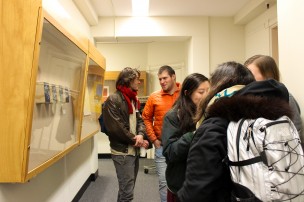Studio art majors take a page from the book of Jim Dine in the Davison Art Center.

Sonya Bessallel/Contributing Photographer
The crowd buzzed with merry conversation in the Davison Art Center’s hallways the evening of Tuesday, Nov. 18. Students, faculty, and art museum employees alike gathered for the gallery’s opening of its newest exhibit, “Create and Curate: Tools.”
Virgil Taylor ’15 curated a similar exhibition with a collection of student art a few years ago. But this exhibit, open until Dec. 7, ties directly into the University, drawing inspiration from the existing collection at the Davison Arts Center.
The curator of the exhibit, Addison McDowell ’16, worked with Friends of the Davison Art Center board member and Assistant Professor of Art Sasha Rudensky to plan the show. The two began ideating last spring, working into the summer to sketch out the details. McDowell wanted a theme that was accessible to many student artists but still left room for variation. What they decided upon was an exhibition inspired by the work of prolific pop artist, painter and sculptor Jim Dine. Davison owns nearly 150 of his prints from 1965 to the present, as well as 213 photogravures Dine gave to the University in honor of a friend.
The theme of tools came primarily from Dine’s prints “Toolbox 1” and “Toolbox 2,” and the included pieces centered on not only the utility of tools, but also their intrinsic value and stand-alone beauty. Patrons seemed to be spellbound by this reimagining of familiar objects in new artistic forms.
“It forces you to consider something that you don’t normally,” McDowell said. “You pick up a pencil, you use it every day, but you don’t consider the design of it, the way that you can kind of mess with it, tweak the meaning, how that tool is relevant to everything that you’re saying, because it’s the object that kind of allows you to say that thing.”
The contributing artists, current sophomores, juniors, and seniors, are all studio art majors with unique takes on the themes. “A Primer for Beginning Sewers,” contributed by Molly Grund ’16, used four constructed cubes of wood, cut paper, and LED lights to depict the stages of threading a needle.
The process of depicting tools in different dimensions was also evident in the work by Samantha Ho ’16, who took a traditional representation of Wite-Out tape, originally designed to be flat and invisible, and made it three-dimensional and visible.
For Taylor, the prompt provided a chance to revisit a remnant of a previous art piece and reexamine its meaning. His painted, cream-colored canvas was originally a throwaway component of a painting he did last fall. Covered in abstract designs, the ambiguous work was reminiscent of moving water or the patterns the wind draws in the sand. Although his piece did not literally focus on tools, Taylor instead chose to examine the painting as an artistic tool.
“It’s the idea of repetition and repeating myself as a thing I do a lot in my art, like repeating elements and that kind of device or repetition as a tool,” Taylor said.
Repetition was also central to the piece contributed by Isaac Pollan ’15, “Mise en Place,” which used laser printing to organize a depiction of nails laid one on top of the other, creating a mesmerizing pattern.
McDowell said the beauty of the exhibit was that no artist had to stick directly to the theme.
“[I curated the works so that] thematically they would relate to one another but be different and individual,” McDowell said.
This reimagining of tools and ideas was best illustrated by two separate works that depicted number two pencils. Miles Cornwall ’15 constructed a pencil out of paper, and although its value as a tool was lost, by its colors and shape it was still instantly recognizable. Evan Ortiz ’16 took the opposite approach: by deconstructing a traditional pencil into each of its material pieces, he subtly remarked on the pencil’s endless usefulness through its extended shape.
For her contribution, Alida Blundon ’16 originally considered depicting digital tools, such as InDesign or Facebook, but ultimately decided to focus on the representation of a tool as both a primal object and as an extension of the self. She started with a scrap piece of wood, machine-cut for someone else’s project, and painted a hand and knife slicing a peach on top, suggesting that the wood slab was a cutting board.
“[I wanted] to blur where the peach ends and the hand begins,” Blundon said. “And the tension of the knife going towards the hand is meant to strike the viewer, to make you uncomfortable a little bit.”
Like Blundon, Harrison Carter ’17 also brought in a multilayered depiction of tools: a graphite drawing on paper of 11 tools and their shadows using graphite on paper.
The exhibit was a success, not only for the artists who were able to show their work and for those who came to enjoy it, but for the Friends of the Davison Art Center as well. Friends Vice President Patricia Reville was enthusiastic about the possibilities it created for the community to engage with art.
“It obviously brings a lot of students in to see what we do,” Reville said. “Now, when the people come to look at this exhibition, it will make them more curious about Dine’s work that also includes all these tools.”